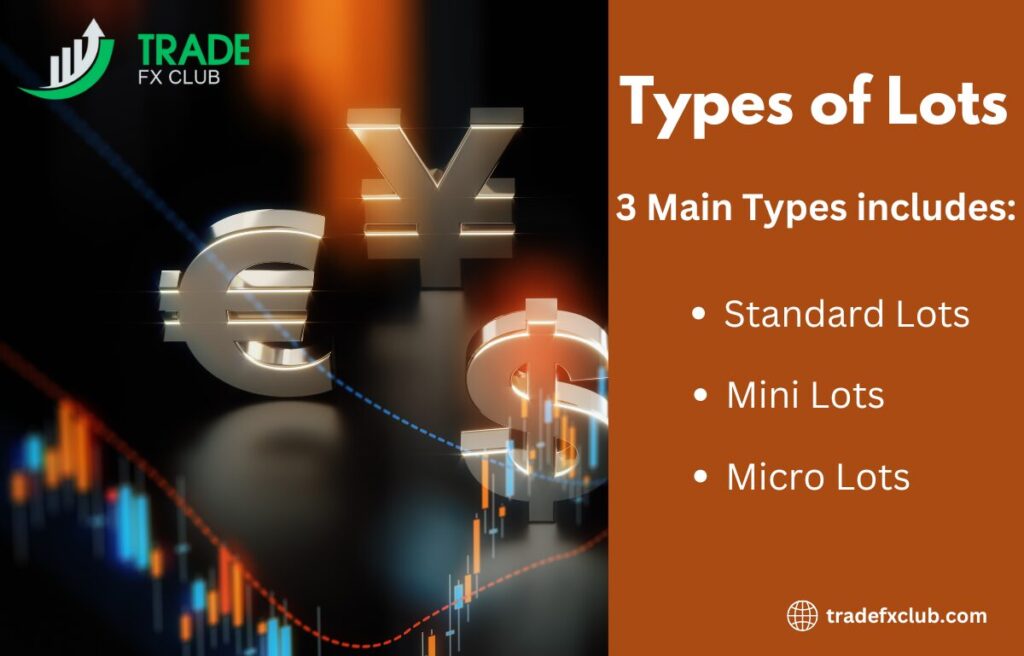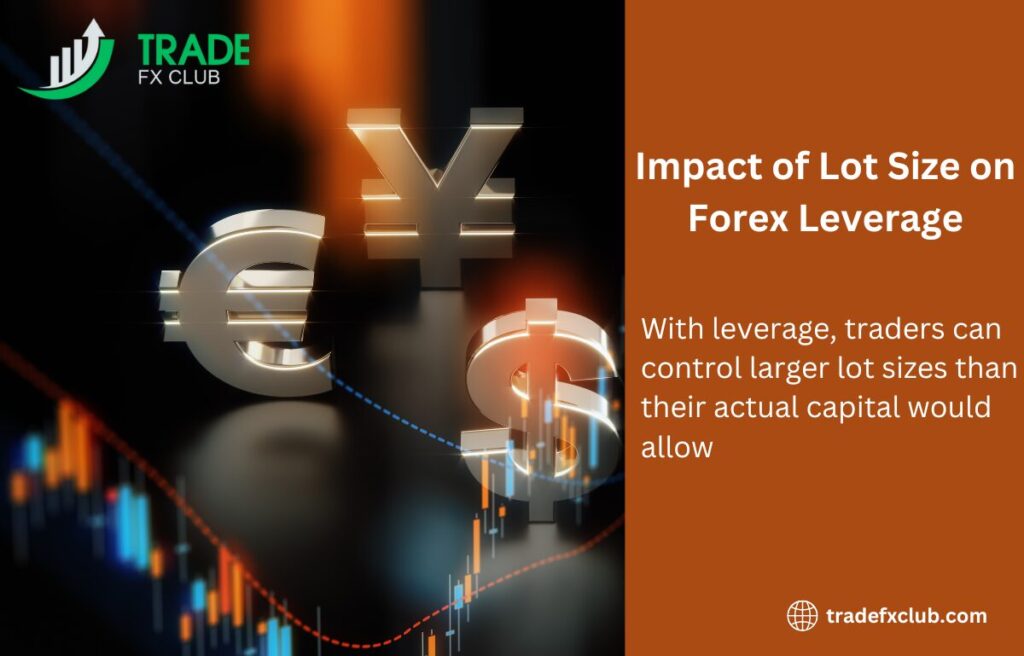In Forex trading, a lot refers to the standardized quantity of a currency pair that you trade in the Forex market. Traditionally, one standard lot is equivalent to 100,000 units of the base currency. The concept of a lot is essential because it standardized the trade size, which ensures uniformity and transparency in the Forex market. Traders can trade in different lot sizes depending on their capital, risk tolerance, and strategy.
The significance of the lot size extends beyond just the number of units. It directly impacts the value of each pip movement in a currency pair. For example, in a standard lot, a single pip movement typically equals $10. As a result, understanding and selecting the appropriate lot size is crucial for managing risks and maximizing potential profits in Forex trading.
What are the Different Types of Lots in Forex?
There are three main types of lots in Forex trading:
Standard Lots: A standard lot is the largest lot size, consisting of 100,000 units of the base currency. Trading in standard lots means that each pip movement equals approximately $10, making it suitable for traders with significant capital and a high-risk tolerance.
Mini Lots: A mini lot is one-tenth of a standard lot, or 10,000 units of the base currency. This lot size is more accessible to retail traders with smaller accounts, as each pip movement equals about $1. Mini lots allow traders to participate in the market with lower risk exposure compared to standard lots.
Micro Lots: A micro lot is one-hundredth of a standard lot, equivalent to 1,000 units of the base currency. With each pip movement worth $0.10, micro lots are ideal for beginners or those with minimal capital. They offer the lowest risk per trade, allowing traders to learn and practice Forex trading without significant financial exposure.

By understanding these different lot sizes, traders can select the appropriate one based on their trading strategy, risk tolerance, and account size, ensuring that their trading activities align with their financial goals.
What is a Micro Lot in Forex, and When Should You Use It?
A micro lot in Forex trading represents 1,000 units of the base currency in a currency pair, making it the smallest lot size available. This means that for every pip movement in the currency pair, the value changes by approximately $0.10. Micro lots are particularly beneficial for beginners or those with smaller trading accounts, as they allow traders to participate in the Forex market with minimal financial exposure. This lower risk makes micro lots an ideal choice for those who are still learning the ropes of Forex trading or who prefer to trade cautiously.
Micro lots are also useful for testing new trading strategies or for trading in highly volatile market conditions where risk needs to be tightly controlled. Since the financial impact of each trade is smaller, traders can afford to make mistakes without incurring significant losses. Additionally, micro lots enable traders to diversify their trades across multiple currency pairs or strategies, spreading out risk and increasing the potential for consistent profits. Overall, micro lots offer a flexible and low-risk entry point into Forex trading, making them a valuable tool for both novice and experienced traders.
What is a Mini Lot in Forex, and How Does It Differ from a Standard Lot?
A mini lot in Forex trading represents 10,000 units of the base currency in a currency pair, which is one-tenth the size of a standard lot. When trading with a mini lot, each pip movement in the currency pair typically equals about $1, making it more accessible and less risky for retail traders compared to a standard lot. Mini lots are especially popular among traders who have moderate account sizes or prefer to take a more conservative approach to risk management.
In contrast, a standard lot consists of 100,000 units of the base currency. Trading with a standard lot means that each pip movement is worth approximately $10, which can lead to larger profits but also exposes the trader to higher risk. The significant difference in pip value between mini and standard lots means that standard lots require a larger account size and a higher risk tolerance. Thus, mini lots provide a middle ground between the lower-risk micro lots and the higher-risk standard lots, making them a versatile option for a wide range of traders.
How Does Lot Size Affect Forex Trading?
The lot size you choose in Forex trading directly influences your profit or loss per pip movement. Larger lot sizes mean that each pip movement has a more substantial impact on your trading account. For instance, trading a standard lot means a one-pip movement equals $10, while a mini lot (10,000 units) equals $1 per pip. Conversely, a micro lot (1,000 units) would mean $0.10 per pip. Therefore, the larger the lot size, the higher the potential profit or loss from each trade.
Choosing the right lot size is a critical part of risk management in Forex trading. Traders need to consider their account size, risk tolerance, and market volatility. For example, a trader with a smaller account may opt for micro or mini lots to manage risk more effectively. In contrast, a trader with a larger account or higher risk tolerance might choose standard lots for more significant profit potential. The key is to balance potential rewards with acceptable levels of risk to ensure long-term success in Forex trading.
How to Choose the Right Lot Size in Forex Trading?
Choosing the right lot size in Forex trading is a critical decision that involves balancing your risk tolerance, account size, and trading strategy. The first step in selecting the appropriate lot size is to assess your risk management strategy. Typically, traders are advised to risk only a small percentage of their trading capital on any single trade, often between 1% and 3%. This risk assessment helps determine the maximum loss you can tolerate per trade, which in turn guides the lot size selection.
Next, consider the volatility of the currency pair you are trading. Highly volatile pairs may require smaller lot sizes to manage risk, while more stable pairs might allow for larger lot sizes. Additionally, traders should factor in the amount of leverage they are using, as higher leverage amplifies both potential gains and losses. By calculating the pip value for the chosen lot size and comparing it to your risk tolerance and market conditions, you can choose a lot size that aligns with your trading objectives and minimizes potential losses.
Why is Understanding Lot Size Important in Forex?
Understanding lot size is fundamental to effective Forex trading because it directly impacts your risk management, potential profits, and overall trading strategy. The lot size determines the value of each pip movement, which in turn affects how much you stand to gain or lose on each trade. For instance, trading a standard lot can yield significant profits, but it also exposes you to greater risk compared to trading mini or micro lots. Without a clear understanding of lot size, traders can unintentionally take on too much risk, leading to substantial losses.
Furthermore, understanding lot size is essential for tailoring your trading strategy to your account size and risk appetite. Beginners or traders with smaller accounts may prefer micro or mini lots to control risk, while more experienced traders with larger accounts might opt for standard lots to maximize their potential returns. Mastering the concept of lot size allows you to make informed decisions that align with your financial goals, trading style, and market conditions, ultimately leading to more consistent and sustainable trading performance.
How to Calculate Pip Value Based on Lot Size?
Calculating the pip value based on lot size is crucial for understanding the financial impact of currency movements in Forex trading. The pip value is determined by multiplying the lot size by the pip value of the currency pair. For a currency pair where the U.S. dollar (USD) is the quote currency, the pip value for a standard lot (100,000 units) is typically $10. For a mini lot (10,000 units), the pip value is $1, and for a micro lot (1,000 units), it is $0.10.
To calculate the pip value for a non-USD quote currency pair, the formula involves dividing the pip value by the current exchange rate. For example, if you’re trading EUR/GBP and the exchange rate is 0.85, the pip value for a standard lot would be calculated as $10 / 0.85 = £11.76. Understanding how to calculate pip value helps traders assess potential profits or losses and tailor their trades to fit their risk management strategies.
What is the Impact of Lot Size on Forex Leverage?
The lot size you choose in Forex trading has a direct impact on the leverage required to open and maintain a trade. Leverage allows traders to control larger positions with a relatively small amount of capital, effectively magnifying both potential gains and losses. When trading larger lot sizes, more leverage is needed to control the position, which increases the financial risk. For instance, trading a standard lot requires more leverage compared to trading a mini or micro lot, meaning that even small market movements can lead to significant profit or loss.

Higher leverage can be both advantageous and dangerous. While it enables traders to amplify their returns, it also increases the potential for rapid losses, especially when using larger lot sizes. It is crucial for traders to carefully consider the relationship between lot size and leverage and to use leverage judiciously to manage risk. By choosing an appropriate lot size in relation to your account balance and risk tolerance, you can better control your exposure to market volatility and avoid excessive losses.
How to Manage Risk with Lot Sizes in Forex?
Managing risk in Forex trading involves carefully selecting the right lot size in relation to your trading strategy, account size, and market conditions. A key principle in risk management is to limit your exposure on each trade by risking only a small percentage of your total capital, typically between 1% and 3%. By doing so, you can withstand multiple losses without depleting your account. Choosing smaller lot sizes, such as mini or micro lots, allows you to adhere to this principle, particularly when trading in volatile markets or when your account size is limited.
Another critical aspect of risk management with lot sizes is the use of stop-loss orders. A stop-loss order automatically closes your position when the market moves against you by a certain amount, helping to limit potential losses. The placement of your stop-loss should be based on your risk tolerance and market analysis, and it should be adjusted according to the lot size you are trading. For example, when trading a standard lot, your stop-loss may be set further away from your entry point to account for larger pip values, whereas with a micro lot, you might place it closer due to the smaller financial impact of each pip.
By combining appropriate lot sizes with sound risk management techniques such as stop-loss orders and position sizing, you can protect your capital and improve your chances of long-term success in Forex trading.
Choosing the right lot size requires careful consideration of your risk management strategy, account size, and the volatility of the currency pair being traded. Smaller lot sizes, such as mini and micro lots, provide a safer entry point for beginners or those with smaller accounts, allowing them to manage risk more effectively. Conversely, standard lots offer higher potential returns but come with increased risk, making them more suitable for experienced traders with larger accounts.
Ultimately, mastering the concept of lot sizes, along with the ability to calculate pip value and understand the impact of leverage, equips traders to make informed decisions that align with their trading objectives. By managing risk through thoughtful lot size selection and strategic use of leverage, traders can navigate the Forex market with greater confidence and sustainability.

